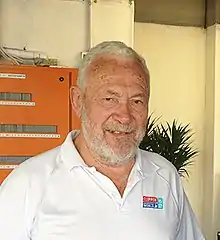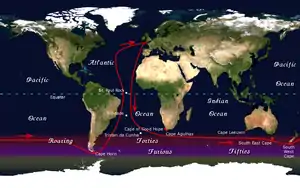Robin Knox-Johnston
Sir William Robert Patrick Knox-Johnston CBE RD (born 17 March 1939) is a British sailor. In 1969, he became the first person to perform a single-handed non-stop circumnavigation of the globe. Along with Sir Peter Blake, he won the second Jules Verne Trophy, for which they were also named the ISAF Yachtsman of the Year award. In 2007, at the age of 67, he set a record as the oldest yachtsman to complete a round the world solo voyage in the Velux 5 Oceans Race.
Robin Knox-Johnston | |
|---|---|
 Robin Knox-Johnston in 2013 | |
| Born | William Robert Patrick Knox-Johnston 17 March 1939 |
| Nationality | British |
| Occupation | Sailor |
| Known for | First single-handed non-stop circumnavigation of the globe |
| Website | robinknox-johnston |
Life
Early life
Knox-Johnston was born in Putney in London, his birth was registered in Wandsworth, in 1939. He was the eldest child of David R Knox-Johnston (1910-1970) and Elizabeth Magill née Cree (1908-1977), who were married in Tring, in 1937.[1]
Knox-Johnston was educated at the Berkhamsted boys' school. From 1957 to 1968, he served in the Merchant Navy and the Royal Naval Reserve. In 1965, he sailed his William Atkins design ketch Suhaili from Bombay to England. Her design is based on the Norwegian sailing lifeboat designs of Colin Archer.
Due to a lack of money he had to interrupt his voyage for work in South Africa as Master of a coaster and stevedoring and was only able to complete it in 1967. In 1968, he was one of nine sailors who attempted to achieve the first solo non-stop circumnavigation of the world in the Sunday Times's Golden Globe race. He was the third sailor to start the race, and the only one to complete the voyage.[2]
Family
In early 1962, in Cambridge, he married Suzanne (Sue) Singer, whom he had known from the age of eight; they had one daughter, Sara, who was born in Bombay whilst he was at sea. His wife left him when he proposed taking her and the child back to England in his new boat Suhaili, and they were divorced in 1967.[3] However, in 1972 they remarried in Winchester, and now have five grandchildren, Florence, Oscar, Xavier, Ralph, and Valentine. Sue died in 2003.[4]
Circumnavigation of the Earth

On 14 June 1968 Knox-Johnston left Falmouth in his 32-foot (9.8-metre) boat Suhaili, one of the smallest boats to enter the Sunday Times Golden Globe Race. Despite losing his self-steering gear off Australia, he rounded Cape Horn on 17 January 1969, 20 days before his closest competitor Bernard Moitessier. Moitessier had sailed from Plymouth more than two months after Knox-Johnston, but he subsequently abandoned the race and instead sailed on to Tahiti. The other seven competitors dropped out at various stages, leaving Knox-Johnston to win the race and become officially the first person to circumnavigate the globe non-stop and single-handed on 22 April 1969, the day he returned to Falmouth. Knox-Johnston donated his prize money for fastest competitor, a sum of £5,000, to the family of Donald Crowhurst, another competitor in the race who had committed suicide after attempting to fake his round the world voyage.
In recognition of his achievement, he was created a Commander of the Order of the British Empire (CBE).
Further exploits
In 1970 (with Leslie Williams) and in 1974 (with Gerry Boxall), Knox-Johnston won the two-handed Round Britain Race. Knox-Johnston, Williams and their crew, which included Peter Blake, took line honours of the 1971 Cape Town to Rio Race. Williams and Knox-Johnston jointly skippered (with Blake a crew member again) maxi yacht Heath's Condor in the 1977 Whitbread Round the World Race. They took the line honours in the second and fourth leg, the ones which Knox-Johnston skippered.[5]
Knox-Johnston and Blake (who acted as co-skippers) won the Jules Verne Trophy for the fastest circumnavigation in 1994. Their time was 74 days 22 hours 18 minutes and 22 seconds. It was their second attempt to win this prize after their first one in 1992 had to be aborted when their catamaran Enza hit an object which tore a hole in the starboard hull.
From 1992 to 2001, Knox-Johnston was president of the Sail Training Association. During his tenure the money was collected to replace the STA's vessels Sir Winston Churchill and Malcolm Miller with the new, larger brigs Prince William and Stavros S. Niarchos. He was trustee of the National Maritime Museum at Greenwich from 1992 to 2002 and still is trustee of the National Maritime Museum – Cornwall at Falmouth, where Suhaili is berthed today. The yacht has been refitted and took part in the Round the Island Race in June 2005.
He was created a knight bachelor in 1995, allowing him to use the honorific title "Sir" in front of his first name.[6]
In 1996, Knox-Johnston established the first Clipper Round the World Yacht Race and has since worked with the Clipper Ventures company as chairman to progress the race to higher levels every year.[7] It is perhaps his greatest achievement to have introduced so many people to competitive sailing via their involvement in Clipper Ventures.
He completed his second solo circumnavigation of the world in the yacht Saga Insurance on 4 May 2007, finishing in fourth place in the Velux 5 Oceans Race.[8] At 68 he was the oldest competitor in the race.[9]
In late 2008 and early 2009, Knox-Johnston took part in a BBC programme called Top Dogs: Adventures in War, Sea and Ice. The programme saw him unite with fellow British legends Sir Ranulph Fiennes, the adventurer, and John Simpson, the BBC world affairs editor. The team went on three trips, each experiencing each other's adventure field. The first episode, aired on 27 March 2009, saw Knox-Johnston, Fiennes and Simpson go on a potentially very dangerous news-gathering trip to Afghanistan. The team reported from the legendary Khyber Pass and infamous Tora Bora mountain complex. The three also undertook a voyage around Cape Horn and an expedition hauling sledges across the deep-frozen Frobisher Bay in the far north of Canada.
Having served two years as president of The Cruising Association, Knox-Johnston is now the association's patron. He is also a past-president of the Little Ship Club.[10]
In November 2014, Knox-Johnston, at age 75, finished the solo transatlantic race the Route du Rhum in third place in the Rhum class. He crossed the finish line on his Open 60 Grey Power at Pointe à Pitre at 16:52 hours local time/20:52 hours GMT after 20 days, 7 hours, 52 minutes and 22 seconds at sea.[11]
During the 2019–2020 coronavirus pandemic, Knox-Johnston was one of several notable figures interviewed by The Guardian about their experiences with social isolation.[12]
Books
- A World of My Own. 1969, Cassell (reissued 2004 by Adlard Coles Nautical).
- A Voyage for Madmen by Peter Nichols, 2001. HarperCollins Publishers.
- Cape Horn, a maritime adventure 1995. Hodder & Stoughton.
- The Columbus venture. 1991, BBC Books.
- Seamanship 1987. Hodder & Stoughton.
- Force of Nature with Kate Laven, 2007. Michael Joseph, London.
- Face to Face: Ocean Portraits, by Huw Lewis-Jones 2010. ISBN 978-1-84486-124-8, Foreword. Conway and Polarworld.
References
- https://www.freebmd.org.uk
- Robin Knox-Johnston (1969). A World of My Own. Cassell & Co Ltd. ISBN 0-304-93473-9. OCLC 76958.
- Robin Knox Johnston (2007). Force of Nature.
- "Sir Robin Knox-Johnston". Retrieved 2 June 2009.
- Knox-Johnston, Robin. "Races: 1977 - Whitbread". Robin Knox-Johnston. Retrieved 25 October 2017.
- Sir Robin Knox-Johnston. "Sir Robin Knox-Johnston's CV". Archived from the original on 2 September 2007. Retrieved 24 August 2007.
- Sir Robin Knox-Johnston. "Sir Robin Knox-Johnston's Blog". Archived from the original on 23 August 2007. Retrieved 24 August 2007.
- "Sailing legend crosses the line". BBC. 4 May 2007. Retrieved 24 August 2007.
- John Elliott (7 May 2006). "Old man of sea Knox-Johnston takes on world". The Sunday Times. Retrieved 2 July 2006.
- "Home". Little Ship Club. Retrieved 19 December 2016.
- "Sir Robin Knox-Johnston third in Route du Rhum – Destination Guadeloupe race". Clipperroundtheworld.com. 22 November 2014. Retrieved 19 December 2016.
- Moss, Stephen (1 April 2020). "'Start a daily routine – and make the weekends different': the isolation experts' guide to lockdown living". The Guardian. ISSN 0261-3077. Retrieved 30 April 2020.
External links
- Robin Knox-Johnston at World Sailing
- Opening the Southampton Boat Show 2008
- Robin Knox-Johnston homepage
- Robin Knox-Johnston Interview
- Robin Knox Johnston Online Game
- Chapter 30 of The Circumnavigators by Don Holm
- Books by Robin Knox-Johnston
| Records | ||
|---|---|---|
| Preceded by Explorer with Bruno Peyron |
Jules Verne Trophy 1994–1997 |
Succeeded by Sport Elec with Olivier de Kersauson |